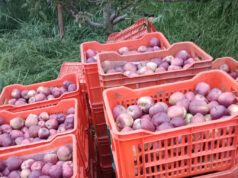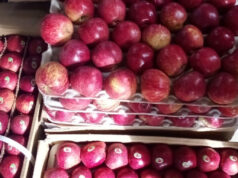Growing apple imports, a worry for apple growers of Himachal, a report compiled by Chetan Singh Bragta.
As per the trade data of Directorate General of Commercial Intelligence and Statistics (DGCIS), Kolkata, for 2012-13, total value of apple imports from SAARC countries is 0.8% of the total value of apple imports. Value of apple imports from Iran is 2.2% of total value of imports of apple in 2012-13.
According to the Directorate General of commercial Intelligence and Statistics, the import of apples had increased by over 50 percent from 134,576 tonnes in 2010-11 to 199,262 tonnes in 2012-13.
DGCIS says China alone exported 73,648 tonnes of apples to India, out of the total Indian import of 188,071 tonnes in 2011-12.
40 % of apples are imported of the total fruits imported to India. During 5-May-2014 to 5-Jun-2014, India imported Apple worth USD 22,810,978. Average value per shipment of Apple imports in India is USD 600,289.
Apple production in the apple producing states of the country may have fluctuated over the last three years, but imports are steadily rising and pose a threat to marketing of the domestic crop. India imported 71,204 tons of apples in 2008-09 which was worth Rs 322.44 crore, in 2009-10 imports rose to 98,895 tons valued at Rs 434.60 crore and in 2010-11 despite a heavy production in the country; 134,577 tons of apples were imported at a value of Rs622.67 crore. For the same period export in 2008-09 the India exported 44,552 metric tons of apples which was worth Rs 52.22 crore, in 2009-10 exports fell to 26,880 tons that was worth Rs 32.10 Cr and in 2010-11, exports increased to 47,076 tons which was worth Rs59.75 crore.
Apple production in the states of Arunachal Pradesh, Himachal Pradesh, Jammu and Kashmir was 1985.1 thousand metric tons in 2008-09, it fell to 1,777 thousand tons in 2009-10 and increased to 2,886 thousand tons in 2010-11. Low value per metric ton of apples exported vis-a-vis the high price for the apples imported. Whereas the apples exported in 2008-09 were priced at Rs 11,721 per ton, it was Rs 11,942 in 2009-10 and Rs 12,692 in 2010-11; the apples imported carried a price tag of Rs 45,284 per ton in 2008-09, it was Rs 43,946 in 2009-10 and Rs 46,269 in 2010-11.
Following the trade liberalization in April 1999, apple imports into India have grown dramatically, reaching 186,387 metric tons valued at US$197 million in 2012 from negligible imports of 20,093 metric tons ten years ago. Despite the fact that India’s 50- percent basic tariff on imported fresh apples is one of the highest in the world; the produce is seeing double-digit growth with every passing year. Strong GDP growth, rise in disposable income, health awareness, and increasing purchasing power are driving the market. Due to their high quality and resultantly high price, imported apples enjoy a separate market position from that of domestic produce. Furthermore, increasing fresh fruit consumption rates also lead to increased demand for imported apples.
Indian apple importers complained that an unknown quantity of gray-market imports of Red Delicious from Iran appeared in the Indian market from January through March 2013 and were falsely attributed to Afghanistan. These apples were generally of inferior quality and according to these traders were entering India primarily overland via Pakistan after being reflagged as of Afghan origin. These allegedly Iranian apples, as well as legally imported Iranian apples, were sold unbranded, and were marketed alongside and in competition with lower-quality domestic Indian apples. Trade data available from the Directorate General of Foreign Trade shows that imports of apples from both Afghanistan and Iran rose significantly in January-March 2013, likely reflecting increased demand for low-priced apples in the Indian market during a period when domestic apples are in short supply.
Apple production in India is low input and low output, as most growers are small or marginal Farmers. Because of the small and fragmented nature of these orchards and the difficult hilly terrain, modern equipment is not economically viable. Therefore, most field operations are conducted manually and yields are reported to be as low as 7.2 MT/Ha, far below international standards.
Consumption Pattern:
The apple is currently the most heavily consumed imported fruit in India. According to industry sources demand for fresh apples is growing in both urban and rural India. The major factors fueling apple demand are increasing population, growing disposable incomes, improving lifestyle, health awareness, and India’s tradition of vegetarianism. India consumes nearly all the fresh apples it produces and consumption exceeds domestic production, reflecting the scope for imported fruit coming into country from various destinations.
Given the current production and consumption scenario, the processed apple sector is poised for growth, although this will greatly depend upon the stability of supply as well as expansion of necessary infrastructure and cold chain system.
It is estimated that 70-80 percent of the Indian apple growers market their produce via organized marketing channels and approximately 85-90 percent of this fruit is consumed fresh – while the rest is exported, processed, or wasted. Unmarketable fruit is procured by the state governments under the Market Intervention Scheme and is further processed with an objective of increasing capacity utilization and assisting the farmers in being remunerated for their produce.
The market shares of apples from the United States and China are 41 percent and 31 percent respectively, followed by Chile, New Zealand, Italy, and others. About 95 to 98 percent of fresh apple imports enter the market through the ports of Mumbai or Chennai; Chennai’s port caters to the states of Tamil Nadu, Karnataka, Odisha, Andhra Pradesh, and West Bengal, while the port of Mumbai supplies the entire western and northern Indian market.
U.S. origin apples are well-positioned in the Indian market as healthful and of better quality than fruit from other origins. In turn, consumers who purchase these high-quality apples tend to repeat the purchase at the next opportunity. This gives a higher return to the traders at various steps of the supply chain. Until recently, the United States had accounted for the largest share of apple imports into India; however, China, Chile, New Zealand, and others have emerged as significant players in India.
While there are no quantitative restrictions on imports, fresh apples (HS Code 08081000) face a basic tariff of 50 percent and are exempted from the educational cess. Import of apples into India requires an invoice, import permit, and phytosanitary certificate to be presented to Indian Customs during clearance. The conditions specified under the Plant Quarantine order 2003 regulate the import of planting seeds and agricultural products (including fresh app required laboratory analysis and the Customs office clears the consignment only after receiving clearance from FSSAI that the consignment is ‘fit for human consumption’(GAIN IN1104 of 2011). Indian law allows use of three edible waxes for surface coating of fresh fruit: beeswax, carnauba wax or shellac wax. If the apples are waxed, the outer packaging is required to be labeled with the name of the wax (GAIN IN8019).
Marketing of imported produce into India:
High import duties, geographical separation from major apple producing countries, and other miscellaneous expenses put together are responsible for the relatively high prices of imported apples in the Indian market. However, marketing opportunities are not limited to the metro cities, which tend to have an increased awareness of health. Imported apples are also finding a place in the daily diets of the expanding middle class population in the so-called ‘tier two’ cities.
Several retail groups have started bringing in small shipments from other countries with the objective of being the most cost effective in the market.









